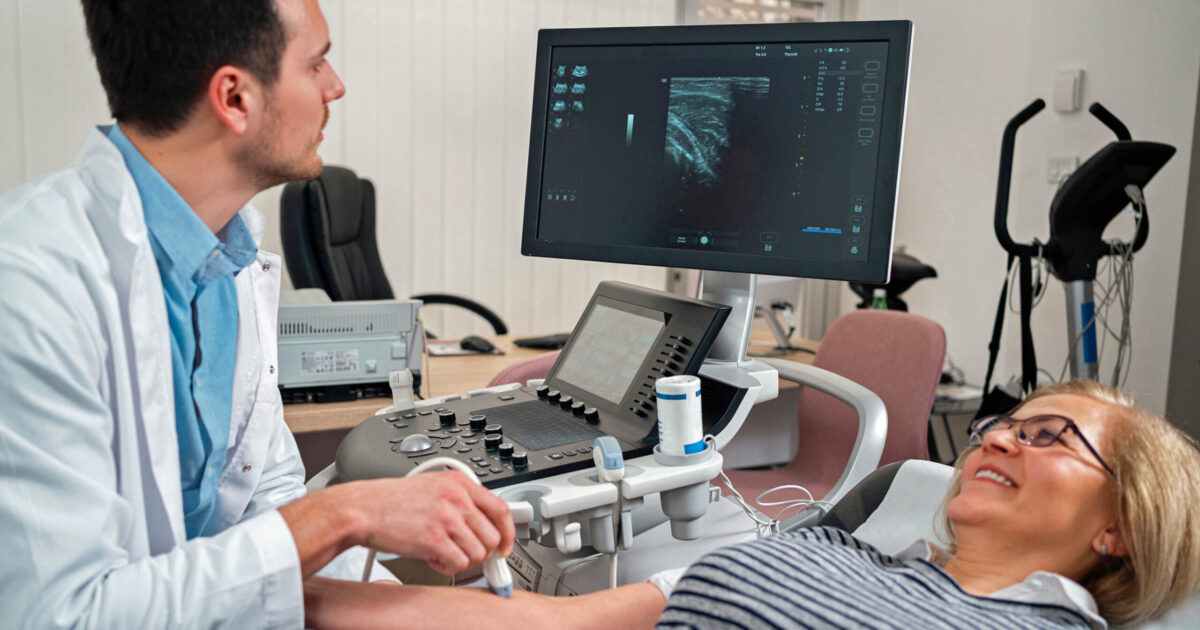If a future career in medical imaging with ultrasound interests you, read on to learn how to become a sonography technician. Sonography is one of the fastest-growing healthcare fields, slated to offer excellent job security over the next decade. It provides an opportunity to work one-on-one with patients, often in relaxed outpatient settings where you can get to know them. You’ll find good pay and plenty of advancement opportunities through specialized training and certification. Vivian Health explores how to start as a sonography technician and then advance in this in-demand career.
What Is Sonography?
You’ve likely heard of sonography under its more common name, ultrasound. It’s a medical imaging field that uses high-frequency sound waves to produce detailed images of the body. This technique is commonly used during pregnancy care when expectant mothers get their first glimpse of their babies. However, sonography is also beneficial in diagnosing and monitoring various medical conditions for any patient of any age or sex. It’s regularly used in cardiology, musculoskeletal care, oncology and more.
Sonographers operate ultrasound equipment, explain procedures to patients and ensure their comfort during imaging. Later, they interpret images and submit their preliminary findings to physicians. They also maintain patient records and calibrate ultrasound equipment as routine parts of the job.

Sonography Technician vs. Sonography Technologist
Learning how to become a sonography technician is often a first step toward ultimately becoming a sonography technologist. A sonography technician is an ultrasound generalist who has earned the required associate degree in sonography. After graduating, a technician completes a practicum period working with patients and is ready to operate ultrasound equipment without supervision. On the other hand, a sonography technologist, also known as a sonographer, has taken the additional step of earning a general certification in the field of ultrasound.
General certification for an Ultrasound Technologist can be earned via the American Registry for Diagnostic Medical Sonography (ARDMS) or the American Registry of Radiologic Technologists (AART). Either sonography certification can help make you more employable, provide better job security and open doors to higher-paying positions within ultrasound.
Because most states don’t require a sonographer technician license, certification is the most direct way to prove your skills to potential employers. The two general certifications offered by ARDMS and AART also allow for additional specialty credentials to work with specific body systems or patient populations.
ARDMS offers the following specialty credentials:
- RDMS Abdomen (AB)
- RDMS Breast (BE)
- RDCS/RDMS Fetal Echocardiography (FE)
- RDCS: Pediatric Echocardiography (PE)
- RDMS Musculoskeletal Sonography (RMSKS)
- RDMS Pediatric Sonography (PS)
- RDMS Obstetrics & Gynecology (OB-GYN)
- Registered Vascular Technologist – Vascular Technology (RVT – VT)
Meanwhile, AART offers additional sonography credentials as well:
For sonographers who work with the heart and circulatory system, Cardiovascular Credentialing International (CCI) offers the following cardiovascular-specific sonography credentials:
- CCI Registered Cardiac Sonographer (RCS)
- CCI Advanced Cardiac Sonographer (ACS)
- CCI Registered Congenital Cardiac Sonographer (RCCS)
- CCI Registered Vascular Specialist (RVS)
- CCI Registered Phlebology Sonographer (RPhs)
Certifications typically require you to take a multi-hour examination demonstrating proficient knowledge of your desired specialty. If you pass the exam, most credentials last for 2 to 3 years and can be maintained and renewed by completing continuing education every 2 to 3 years as well. There are fees associated with both your initial certification and ongoing renewals.

Specialization within Sonography
Most sonographers start as generalist Diagnostic Medical Sonographers. However, there are numerous specialty fields within sonography.
- Cardiovascular sonographers, echo-vascular techs and echo techs evaluate the heart (i.e., echocardiography) and/or circulatory system for conditions like blockages or valve dysfunction. They may subspecialize in certain patient populations, such as fetal echocardiography, pediatric echocardiography and adult echocardiography.
- Obstetrics and gynecology (OB-GYN) sonographers monitor fetal development during pregnancy and evaluate reproductive health.
- Breast sonographers examine the health of breast tissue, including monitoring for cancer.
- Musculoskeletal sonographers examine muscles, tendons and joints for injuries or disorders.
- Pediatric ultrasound technologists specialize in imaging children, from infants to teens.
The most common path to specialization is to work in a setting where you deal with the relevant patient population, gain experience and then earn a certification relevant to that specialty.
Other avenues for possible career advancement exist. Some sonographers pursue advanced degrees in diagnostic imaging or healthcare management, including a bachelor’s or master’s degree. With these degrees, it’s possible to work in a supervisory role, pursue jobs in academia, or contribute to advancements in imaging technology through research.
RELATED: The Highest-Paying Sonography Specialties in 2024
Technical and Soft Skills to Excel in Sonography
Being a successful sonographer involves a blend of technical and soft skills that are useful daily and with every patient interaction.
Technical Skills Needed to Operate Sonographic Equipment
A sonographer technician learns mastery in the following areas through their education and practicum.
- Proficiency in Imaging Techniques: Learning to effectively use various types of imaging techniques (e.g., Doppler, 3D/4D imaging).
- Equipment Operation: Skills in using sonographic machines, troubleshooting issues and calibrating equipment.
- Anatomical Knowledge: Ability to recognize and analyze anatomical structures to produce accurate diagnostic images.
- Technology Adaptability: Staying updated with advancements in sonographic technology and software.
- Image Quality Assessment: Ensuring images meet diagnostic standards for clarity and detail.
Soft Skills to Become a Sonography Technician
Working in medical imaging requires a fair amount of direct contact with patients, and there can be many of them on any given shift. As such, developing a range of soft skills becomes important.
- Communication: Explaining procedures to patients clearly and answering questions compassionately.
- Attention to Detail: Identifying subtle abnormalities in images for accurate diagnosis.
- Empathy: Maintaining a professional and empathetic demeanor to help patients feel comfortable during procedures.
- Time Management: Scheduling and performing procedures efficiently while balancing multiple tasks.
- Critical Thinking: Interpreting findings and responding to unexpected results or complications promptly.
Promising Sonography Technicians’ Job Outlook
If you’re considering a sonography career, think about the excellent job security. Sonography is near the top of the list of fastest-growing allied healthcare careers. According to the Bureau of Labor Statistics, a U.S. agency that tracks and projects growth for different job types, sonographers will experience 15% job growth from 2023 to 2033, well above the average of 4% for all job categories in the nation. Due to the demand and the skills involved, the typical sonographer technician’s salary is also well above the U.S. average salary.
RELATED: Which States Have the Best Pay and Job Opportunities for Sonographers?
The demand for sonographers is increasing due to advancements in imaging technology, the growing preference for non-invasive diagnostic methods and an aging population requiring more medical imaging for chronic health conditions.
Sonographers are needed wherever there are patients, so the states with the most jobs also have the highest populations. These include California, Texas, New York, Florida and North Carolina, among others. However, certain smaller states have a higher-than-average number of sonographers based on their population size, including Alaska, West Virginia, South Dakota, Michigan and Rhode Island.

Taking Charge of Your Sonography Career
Though sonography jobs are plentiful, attaining your ideal position requires strategically navigating the healthcare job market to stand out and secure the right opportunities. From crafting a compelling resume to networking effectively, here are some practical steps to help you succeed.
Crafting a Strong Resume
Your resume is often the first impression a potential employer will have of you, so make it count. Prominently display your certifications at the top. Employers want to see that you’re qualified and specialized, whether that’s in vascular, cardiac or obstetric sonography.
Detailing your clinical experience is also critical. If you’ve completed internships or externships, include specifics about the types of imaging you performed, the equipment you used and the patient populations you served. Use action-oriented language and quantify achievements where possible. For instance, instead of simply stating, “Performed ultrasound imaging,” you might write, “Performed over 1,000 abdominal ultrasound scans with a 98% accuracy rate in initial diagnostic findings.”
Tailoring your resume to each job description is another way to stand out. Review the job posting carefully and emphasize the skills and experiences that align most closely with the employer’s needs. Keep your formatting professional and easy to read.
Sonographer Networking Strategies
Building a strong professional network can open doors to job opportunities that aren’t always advertised. Stay in touch with instructors, mentors and classmates from your training—they can often provide valuable referrals or job leads. Platforms like LinkedIn are also powerful tools for expanding your network. Create a professional profile highlighting your skills and join groups focused on diagnostic imaging to engage in industry discussions.
In-person networking is equally valuable. Attend industry conferences, workshops and job fairs to meet professionals and learn about openings. Some of the best opportunities arise from conversations at these events, so don’t be shy about introducing yourself and expressing your career goals. Attending conferences hosted by organizations like the Radiological Society of North America (RSNA) or the American Society of Echocardiography (ASE) can help you stay updated on advancements.
If you’re proactive, consider contacting imaging centers or hospitals where you’d like to work. Even if they don’t have immediate openings, making a positive impression can lead to future opportunities.
Finally, memberships in professional organizations can enhance your credibility and provide access to career growth resources. Groups like the Society of Diagnostic Medical Sonography (SDMS) offer networking opportunities, career tools and continuing education courses. Similarly, the ARDMS and CCI provide certifications and keep you informed about industry standards.
Search for Top Sonography Technician Jobs
By taking a strategic approach to your job search, you can position yourself as a well-rounded candidate. Focus on presenting your technical skills and certifications while demonstrating your ability to connect with patients and collaborate with healthcare teams. With a strong resume, thoughtful interview preparation and a robust professional network, you’ll be well-equipped to launch and advance your career in sonography.
Once trained and ready to become a sonography technician, Vivian Health can help you find your ideal job. Top healthcare facilities and recruiters share jobs for all types of sonographers on our platform every day. Register with Vivian to get started.






















